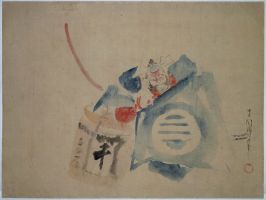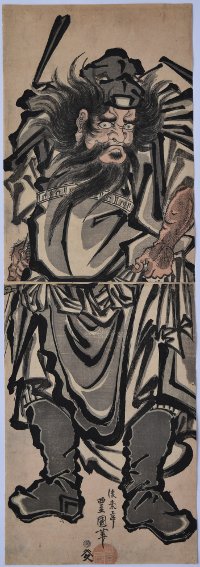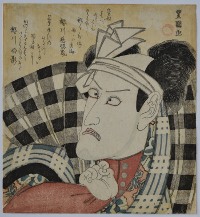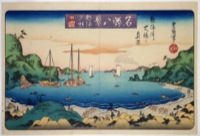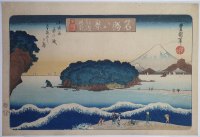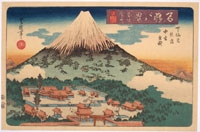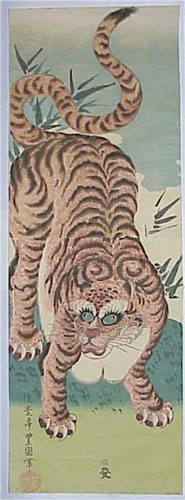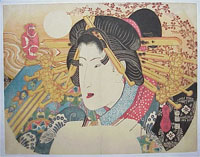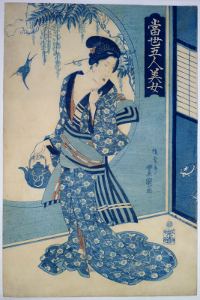Utagawa TOYOKUNI II (TOYOSHIGE) (1777-1835)
Click here to view image full size.
An original painting on paper, unmounted, showing Asahina Saburo (Wada no Saburo Yoshihide), a famous warrior of the early Kamakura period (1185-1333). Image size 11.5 x 15.5 in; 29.2 x 39.5 cms. Signed Toyokuni suichu hitsu, “Toyokuni painted while being drunk.”
Status: Sold
Utagawa TOYOKUNI II (TOYOSHIGE) (1777-1835)
Click here to view image full size.
A vertical diptych of Shoki, the Demon Queller. The character originates from China being a deity from China’s Taoist pantheon. He is always shown with his scholar’s hat, large robe and boots, and usually carrying a sword with which he attacks oni. Images of Shoki were hung outside houses to ward off evil during the Boys’ Day Festival on May 5th. Published by Yamamoto Kyubei, c 1820. Prints by Toyoshige are often misattributed to Toyokuni I and vice versa because late Toyokuni I signatures and those of Toyoshige are similar. Rare.
Very good impression and colour. Some edge soil, otherwise very good condition. Signed Gosotei Toyokuni hitsu.
Status: Sold
Utagawa TOYOKUNI II (1777-1835)
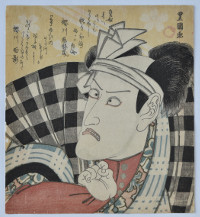
Click here to view image full size.
A surimono showing a bust portrait of the actor Ichikawa Danjuro VII as Kanawa no Goro, a retainer of Kamatari no Fujiwara, disguised as the fisherman Fukashichi from the Mikasayama Goten scene at the palace on Mount Mikasa in Act 4 of Imoseyama onna teikino. Three poems by Shoshokyo Otokado, Sakuragawa Jihinari and Sakuragawa Omokage. Issued c. mid 1820s. Rare.
Fine impression. Very good colour and condition. Signed Toyokuni ga.
Status: Sold
Utagawa TOYOKUNI II (1777-1835)
Click here to view image full size.
A surimono showing a bust portrait of the actor Ichikawa Danjuro VII as Kanawa no Goro, a retainer of Kamatari no Fujiwara, disguised as the fisherman Fukashichi from the Mikasayama Goten scene in Act 4 of Imoseyama onna teikino. Three poems by Shoshokyo Otokado, Sakuragawa Jihinari, and Sakuragawa Omokage. Issued c mid-1820s. Provenance: originally purchased from me in 1977 (see my catalogue 20, 1977, no. 38). Unidentified collector’s seal au verso. Rare.
Very good impression, colour and condition. Signed Toyokuni ga.
Status: Sold
Utagawa TOYOKUNI II (TOYOSHIGE ) ( 1777-1835 )
Click here to view image full size.
Evening Glow ( Sunset ) at Atami, Shizuoka Prefecture. From a set Meisho hakkei, “Eight Views of Famous Places” ( based on the Eight Views of Omi theme ). Published 1830s by Iseri. The town is famous for the Onsen hot springs and the area is known for its past volcanic activity. Across Sagami Bay can be seen smoke coming from the volcanic island of Oshima ( the epicentre of the great Kanto earthquake of 1923 ).
Fine impression and colour.There are two states of this set: one with square and one with cursive script ( as here ) in the oblong cartouche at top. It is unclear which is the earliest. This purple cartouche is often faded out to a puce colour. Slight centre fold otherwise very good condition. Signed Toyokuni hitsu.
Status: Sold
Utagawa TOYOKUNI II (TOYOSHIGE) (1777-1835)
Click here to view image full size.
Clearing weather over the Enoshima Island from a Meisho hakkei, “Eight Views of Famous Places” ( based on the Eight Views of Omi theme ) set published 1830s by Iseri. A view of the island from Shichiri Beach in Sagami Province. The island was dedicated to Benten ( one of the seven gods of good luck ).
Fine impression. There are two states of this set: one with square and one with cursive script ( as here ) in the oblong cartouche at top. It is unclear which is the earliest. Fine impression. Small expert restoration to two upper corners, otherwise fine colour and condition. Signed Toyokuni hitsu.
Status: Sold
Utagawa TOYOKUNI II (1777-1835)
Click here to view image full size.
Fuji bosetsu, Evening Snow on Fuji from a set of Eight Famous Views published by Iseya Rihei, c. 1833-4. Fuji towers over a religious compound. Toyokuni, like Kuniyoshi, Kunisada, Gakutei and Hokkei, while not known as a landscapes artist, produced a few fine examples, as here. Rare.
Very fine impression and colour. Fine condition. The first edition: It’s not generally known that there are two editions with the title recut. Also, the purple colour in the title label invariably fades to a puce colour. Signed Toyokuni hitsu.
Status: Sold
Utagawa TOYOKUNI II (1777-1835)
Click here to view image full size.
A vertical diptych showing a tiger. A striking design published by Yamamotoya Heikichi c1820s.
Fine early impression with gauffrage. Fine colour. Slight creasing and small edge repair, but otherwise very good, Full size. Signed Gosotei Toyokuni hitsu.
Status: Sold
Utagawa TOYOKUNI II (1777-1835)
Click here to view image full size.
A bust portrait of a beauty in the form of a fan from a series of the Six Tama Rivers, this being the Ide (or Hagi) no Tamagawa in Yamashiro. Published by Tsujiokaya Bunsuke with date seal 1823.
Very fine impression and colour. Very faint centrefold. Signed Toyokuni ga.
Status: Sold
Utagawa TOYOKUNI II ( TOYOSHIGE ) (1777-1835)
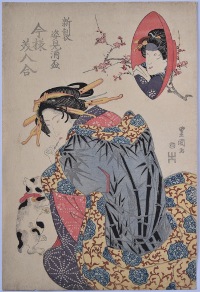
Click here to view image full size.
A courtesan with a toothpick and playing with a cat compared to the actor Iwai Hanshiro V ( inset in a sake cup top right ). From a series Imayo bijin awase, shinsei sugatami sakazuki, “A Comparison of Modern Beauties – A New Mirror of Sake Cups.” Published by Imariya Ushizo, c 1820-24.
Very good impression, colour and condition. Extensive mica added to the coat of the courtesan. Signed Toyokuni ga.
Status: Sold
Utagawa TOYOKUNI II (1777-1835)
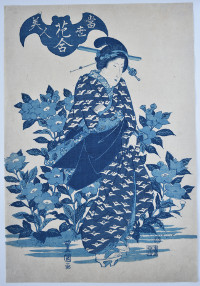
Click here to view image full size.
An aizuri (blue) print from a set Tosei bijin hana-awase, “Beauties of the Latest Fashion Compared to the Beauty of Flowers.” In this case kikyo flowers – the Chinese bellflower. Aizuri prints were the outcome of avoiding intermittent edicts promulgated by the bakufu prohibiting the number of blocks that could be used. The aim being to curb excesses, raise moral standards and encourage thrift. Published by Shimizo, c. late 1820s. Three other prints from set are in the Brooklyn Museum of Art, 76.151.13; 14; 15.
Fine impression, colour and condition. Signed Toyokuni ga.
Status: Sold
Utagawa TOYOKUNI II (1777-1835)
Click here to view image full size.
A beauty standing beside a circular window with wisteria and a swallow, both symbols of spring. From an aizuri-e set Tosei gonin bijo, “Fine Modern Beauties.” Published by Maruya Seijiro, c 1830-5.
Very good impression, colour and condition. Signed Gosotei Toyokuni ga.
Status: Sold
Toyokuni – painted while drunk
In the current update is a painting signed “Toyokuni painted while being drunk.” This is not an isolated example: Certain artists – such as Kyosai – often signed works in this way and indeed may have benefited from a degree of inebriation to prompt inspiration. Artists often collaborated on works, especially of the Shijo school, and one can imagine the conviviality of such a cohors amicorum with food and wine being passed around. It’s difficult to think of a western comparison to this. Hand scrolls, because of their horizontal length and short height, were very suitable for joint efforts of like-minded artists or literati.
The example in this update is spontaneous – even slapdash – due to the artist’s intoxication, but this adds a charm and veracity to the subject. It also makes authentication easier, certainly of Ukiyoe subjects, as forgers tended to concentrate on copying the detailed, more sober and meticulous subjects, as these were the most highly valued.
Japanese paintings are an undervalued area of collecting. It’s possible, as here, to buy an important Hiroshige painting for the price many of his prints fetch. And one is purchasing an unique item.
Artists
( A to Z )
Kyogado ASHIKUNI ( Fl. c. 1807 – 1818 )
Gigado ASHIYUKI ( Fl. c. 1814 – 1833 )
Ki BAITEI ( 1734 – 1810 )
Takizawa BAKIN ( 1767 – 1848 )
Ono BAKUFU ( 1888 – 1976 )
Georges BIGOT ( 1860 – 1927 )
Kawamura BUMPO ( 1779 – 1821 )
Ippitsusai BUNCHO ( Fl. c. 1765 – 1792 )
Toyohara CHIKANOBU ( 1838 – 1912 )
Kishi CHIKUDO ( 1826 – 1897 )
Tsubaki CHINZAN ( 1801 – 1854 )
Eishosai CHOKI ( Fl. c. 1756 – 1808 ). See also SHIKO
Rekisentei EIRI ( Fl. c. 1790 – 1800 )
Keisai EISEN ( 1790 – 1848 )
Hosoda EISHI ( 1756 – 1829 )
Hosoda EISHO ( Fl. c. 1780 – 1800 )
Ichirakutei EISUI ( Fl. c. 1790 – 1823 )
Kikugawa EIZAN ( 1787 – 1867 )
Hirano HAKUHO ( 1879 – 1957 )
Elizabeth KEITH ( 1887 – 1956 )
Imao KEINEN ( 1845 – 1924 )
Yashima GAKUTEI ( 1786 – 1868 )
Ogata GEKKO ( 1859 – 1920 )
Adachi GINKO ( Fl. c. 1847 – 1897 )
Matsumura GOSHUN ( 1752 – 1811 )
GYOSAI. See Kawanabe KYOSAI
Hirano HAKUHO ( 1879 – 1957 )
Suzuki HARUNOBU ( 1724 – 1770 )
Kawase HASUI ( 1883 – 1957 )
Kitagawa HIDEMARO ( Fl. c. early 19th century )
Kinoshita HIRONOBU ( Fl. c. 1851 – 1870 )
Gosotei HIROSADA ( Fl. c. 1847 – 1863 )
Ichiryusai HIROSHIGE ( 1797 – 1858 )
Ichiryusai HIROSHIGE II ( 1826 – 1869 )
Ando HIROSHIGE III ( 1843 – 1894 )
Nakamura HOCHU ( Fl. c. late 18th to early 19th century )
Sakai HOITSU ( 1761 – 1828 )
Totoya HOKKEI ( 1780 – 1850 )
Teisai HOKUBA ( 1771 – 1844 )
Shunkosai HOKUEI (Active 1824-1837)
Katsushika HOKUGA ( Fl. c. 1830 )
Shotei HOKUJU ( Fl. c. 1789 – 1818 )
Katsushika HOKUSAI ( 1760 – 1849 ). Also used numerous other names such as: SORI, SHUNRO, SHINSAI
Shokosai HOKUSHU ( Fl. c. 1808 – 1832 )
KEISAI. See Kitao MASAYOSHI
Suzuki KIITSU ( 1796 – 1858 )
Kitagawa KIKUMARO ( Fl. c. ? – 1830 ). See TSUKIMARO
Kobayashi KIYOCHIKA ( 1847 – 1915 )
Torii KIYOHIRO ( Fl. c. 1737 – 1771 )
Torii KIYOMASA ( Fl. c. 1700 – 1722 )
KIYOMINE. See Torii KIYOMITSU II
Torii KIYOMITSU ( 1735 – 1785 )
Torii KIYOMITSU II ( 1787 – 1868 ). See KIYOMINE
Torii KIYONAGA ( 1752 – 1815 )
Torii KIYONOBU ( 1664 – 1729 )
Torii KIYONOBU II ( 1706 – 1763 )
Torii KIYOTSUNE ( Fl. c. 1757 – 1779 )
Isoda KORYUSAI ( Fl. c. 1767 – 1788 )
Ohara KOSON ( 1877 – 1945 ). See SHOSON
Torii KOTONDO ( 1900 – 1976 )
Toyohara KUNICHIKA ( 1835 – 1900 )
Utagawa KUNIHIRO ( Fl. c. 1815 – 1843 )
Ichiunsai KUNIHISA ( 1832 – 1891 )
Utagawa KUNINAO ( 1793 – 1854 )
Utagawa KUNISADA ( 1786 – 1865 )
Utagawa KUNISADA II ( 1823 – 1880 )
Utagawa KUNISATO ( ? – 1858 )
Utagawa KUNITERU ( 1808 – 1876 )
KUNITERU. See Utagawa SADASHIGE
Utagawa KUNITERU II ( 1829 – 1874 )
Utagawa KUNIYASU ( 1794 – 1832 )
Ichiyusai KUNIYOSHI ( 1797 – 1861 )
Santo KYODEN. See Kitao MASANOBU
Kawanabe KYOSAI ( 1831 – 1889 ). See GYOSAI
Okumura MASANOBU ( 1686 – 1764 )
KitaoMASANOBU ( 1761 – 1816 ). See Santo KYODEN
Kitao MASAYOSHI ( 1764 – 1824 ). See KEISAI
Oishi MATORA ( 1794 – 1833 )
Hishikawa MORONOBU ( Fl. c. 1618 – 1694 )
Nishimura NANTEI ( 1775 – 1834 )
Utagawa NOBUKATSU ( Fl. c. 1830 – 1844 )
Watanabe NOBUKAZU ( Fl. c. late 19th century )
Hishikawa RYUKOKU ( Fl. c. 1808 – 1816 )
Jokei RYUKOSAI ( Fl. 1772 – 1816 )
Gokitei SADAFUSA ( Fl. c. 1825 – 1850 )
Hasegawa SADAHARU ( Fl. c. 1830 – 1844 )
Gokotei SADAKAGE ( Fl. c. 1818 – 1844 )
Utagawa SADAHIDE ( 1807 – 1873 )
Hasegawa SADANOBU ( 1809 – 1879 )
Utagawa SADASHIGE ( Fl. c. mid 19th century ). See KUNITERU
Gofutei SADATORA ( Fl. c. 1825 )
Yamaguchi SHIGEHARU ( 1803 – 1853 )
Kitao SHIGEMASA ( 1739 – 1820 )
Nishimura SHIGENAGA ( 1697 ? – 1756 )
Nishimura SHIGENOBU ( Fl. c. 1724 – 1735 )
SHIKO. See Eishosai CHOKI
Ryuryukyo SHINSAI ( 1764 – 1820 )
Ito SHINSUI ( 1898 – 1972 )
Kojima SHOGETSU ( Fl. c. 1880 – 1890 )
SHOSON. See Ohara KOSON
Takahashi SHOTEI ( 1871 – 1945 )
Yamamoto SHOUN ( 1870 – 1965 )
Yamakawa SHUHO ( 1898 – 1944 )
Katsukawa SHUNCHO ( Fl. c. 1780 – 1795 )
Takehara SHUNCHOSAI ( Fl. c. 1772 – 1801 )
Katsukawa SHUN’EI ( 1762 – 1819 )
Katsukawa SHUNKO ( 1743 – 1812 )
Hishikawa SHUNKYO ( Fl. c. early 19th century )
Kubo SHUNMAN ( 1757 – 1820 )
Katsukawa SHUNSEN ( Fl. c. 1762 – 1830 )
Natori SHUNSEN ( 1886 – 1960 )
Gatoken SHUNSHI ( Fl. c. 1820 – 1828 )
Katsukawa SHUNSHO ( 1726 – 1792 )
Katsukawa SHUNTEI ( 1770 – 1820 )
Katsukawa SHUNZAN ( Fl. c. 1782 – 1798 )
Yamaguchi SOKEN ( 1759 – 1834 )
Ikeno TAIGA ( 1723 – 1776 )
Katsukawa TERUSHIGE ( Fl. c. 1715 – 1725 )
Mori TETSUZAN (1775-1841)
Migita TOSHIHIDE ( 1863 – 1925 )
Mizuno TOSHIKATA ( 1866 – 1908 )
Okumura TOSHINOBU ( Fl. c. 1717 – 1750 )
Utagawa TOYOHARU ( 1735 – 1814 )
Utagawa TOYOHIRO ( 1773 – 1828 )
Utagawa TOYOKUNI ( 1769 – 1825 )
Utagawa TOYOKUNI II ( 1777 – 1835 ). See TOYOSHIGE
Yamamura TOYONARI ( 1885 – 1942 )
Ishikawa TOYONOBU ( 1711 – 1785 )
TOYOSHIGE. See Utagawa TOYOKUNI II
TSUKIMARO. See Kitagawa KIKUMARO
Kitano TSUNETOMI ( 1880 – 1947 )
Toyokawa UMEKUNI ( Fl. c. 1816 – 1826 )
Kitagawa UTAMARO ( 1753 – 1806 )
Kitagawa UTAMARO II ( ? – 1831 )
Inoue YASUJI ( 1864 – 1889 )
Hiroshi YOSHIDA ( 1876 – 1950 )
Ipposai YOSHIFUJI ( 1828 – 1887 )
Utagawa YOSHIIKU ( 1833 – 1904 )
Utagawa YOSHIKATA ( Fl. c. 1841 – 1864 )
Utagawa YOSHIKAZU ( Fl. c. 1850 – 1870 )
Toyokawa YOSHIKUNI ( Fl. c. 1803 – 1840 )
Utagawa YOSHIMUNE ( 1817 – 1880 )
Ichiyosai YOSHITAKI ( 1841 – 1899 )
Utagawa YOSHITORA ( Fl. c. 1850 – 1880 )
Taiso YOSHITOSHI ( 1839 – 1892 )
Utagawa YOSHITSURU ( Fl. c. 1840 – 1850 )
Ichieisai YOSHITSUYA ( 1822 – 1866 )
Mori YOSHIYUKI ( 1835 – 1879 )
Shibata ZESHIN ( 1807 – 1891 )
